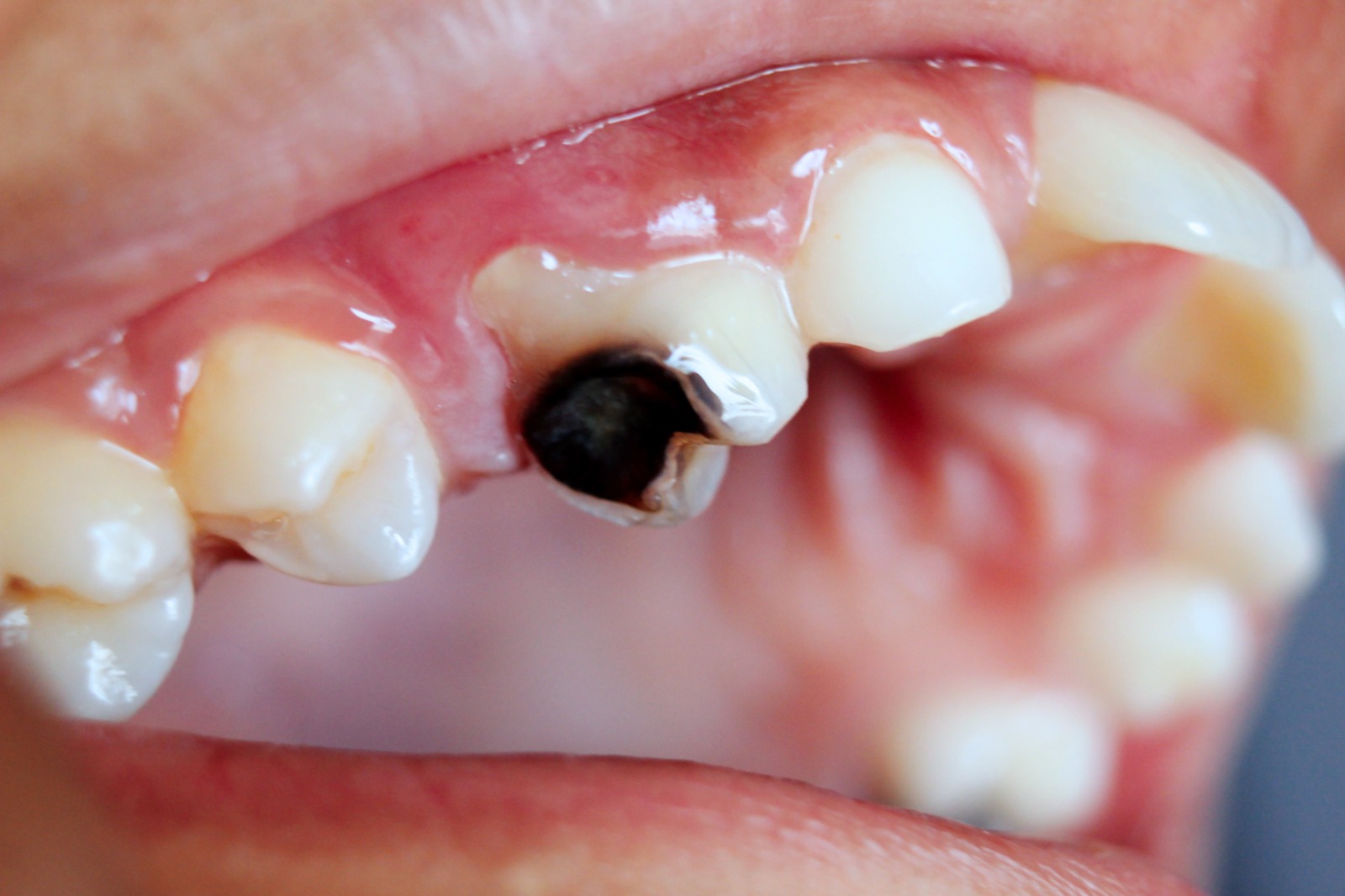The Science behind Cavities: What Every Parent Should Know
What Are Cavities and How Do They Form?
Definition of Cavities (Tooth Decay)
At its core, a cavity is a result of tooth decay—a progressive process where the enamel (the tooth’s outermost protective layer) is destroyed by acids. When left untreated, decay can extend deeper into the tooth, affecting the dentin and eventually reaching the pulp, which may cause pain, infection, and even tooth loss.
The Role of Bacteria, Sugar, and Acid in Enamel Breakdown
Cavities don’t just appear overnight. They are the result of a complex interaction between bacteria, dietary sugars, and the mouth’s environment. Here’s what happens:
- Bacteria in the Mouth: The mouth naturally harbors many types of bacteria. Some of these bacteria, like Streptococcus mutans, feed on sugars and starches left behind after your child eats.
- Sugar and Acid Production: When bacteria digest these sugars, they produce acid as a byproduct. This acid is what starts to attack and weaken the enamel.
- Plaque Formation: The mixture of food particles, bacteria, and acid forms a sticky substance called plaque, which adheres to the teeth—especially in hard-to-clean areas like grooves, between teeth, or near the gumline.
If plaque is not removed regularly through brushing and flossing, it continues to produce acid that erodes enamel and allows cavities to form.
The Demineralization and Remineralization Process
To understand cavities, it’s important to know about the natural cycle of demineralization and remineralization:
- Demineralization: This occurs when acids from bacteria attack the tooth enamel, causing it to lose essential minerals like calcium and phosphate. Early signs of demineralization can appear as white spots on the teeth.
- Remineralization: Thankfully, our bodies have a natural defense. Saliva helps neutralize acids and contains minerals that aid in the repair of enamel. Fluoride—often found in toothpaste, water, and dental treatments—enhances this process by strengthening the enamel and making it more resistant to future acid attacks.
However, when the balance tips in favor of demineralization—due to frequent sugar consumption, poor oral hygiene, or inadequate fluoride—cavities begin to form.
Why Children Are More Prone to Cavities
Baby Teeth Are Thinner and More Vulnerable
Children’s baby teeth, or primary teeth, are not just smaller versions of adult teeth—they’re also structurally different. The enamel on baby teeth is much thinner and softer than that on permanent teeth. This means that once decay starts, it can spread more quickly through the tooth and reach the inner layers (dentin and pulp) in less time.
Because of this thinner enamel:
- Cavities in baby teeth can develop rapidly.
- Minor decay can become a major problem if not caught early.
- Even a small cavity can lead to pain, infection, or early tooth loss.
Many parents assume baby teeth aren’t that important because they eventually fall out, but untreated cavities can impact a child’s ability to chew, speak clearly, and even affect the development of their permanent teeth.
Inconsistent Oral Hygiene Habits
Let’s face it—most young children aren’t brushing and flossing experts. Inconsistent or improper brushing and flossing allows plaque and bacteria to build up, creating the ideal environment for cavities to form.
Common issues include:
- Not brushing twice a day or rushing through it.
- Missing key areas like back molars or along the gumline.
- Skipping flossing altogether, which is essential for cleaning between teeth.
Young children often lack the motor skills needed for thorough brushing and need parental supervision until at least age 7 or 8. Without guidance and routine, poor oral hygiene habits can quickly lead to decay.
High-Sugar Diets and Frequent Snacking
Diet plays a major role in cavity development—and children’s diets often include more sugar than recommended. From juice boxes and fruit snacks to candy, cookies, and sugary cereals, kids are frequently exposed to foods that fuel cavity-causing bacteria.
What’s more concerning is the frequency of snacking:
- Constant snacking means that teeth are under near-constant acid attack.
- Each time your child eats something sugary or starchy, the bacteria in their mouth produce acid that softens enamel.
- Without enough time between snacks, saliva doesn’t have a chance to neutralize the acid and remineralize the enamel.
Even “healthy” snacks like dried fruit or flavored yogurt can contribute to cavities if eaten too often or not followed by brushing or rinsing.
Warning Signs of Cavities in Kids
Sensitivity to Hot, Cold, or Sweet Foods
One of the earliest signs of a cavity is tooth sensitivity, especially when eating or drinking:
- Cold treats like ice cream, hot soups, or sugary snacks may cause sudden discomfort or a lingering twinge.
- This sensitivity happens because the enamel has worn down and exposed the dentin underneath, where tiny nerve endings respond to temperature changes and sugar.
- If your child avoids certain foods or winces while eating, it could be a subtle clue that decay is developing.
Don’t ignore sensitivity, even if your child isn’t complaining. It’s often a red flag that something is wrong beneath the surface.
Visible Spots or Holes in Teeth
Cavities don’t always cause pain in the beginning, but they can often be seen if you know what to look for:
- White spots may indicate the early stages of enamel breakdown.
- As the decay progresses, brown or black spots, or even visible holes or pits, may form on the tooth’s surface.
- These changes most commonly appear on the chewing surfaces of back molars, between teeth, or near the gumline.
During daily brushing, take a moment to inspect your child’s teeth or have them open wide so you can check for discoloration or changes in texture.
Complaints of Tooth Pain or Discomfort
Once a cavity reaches the inner layers of the tooth, your child may begin to experience toothaches or general discomfort:
- Pain may be constant or come and go, and it might intensify when chewing.
- Your child may complain of a tooth that “feels funny” or hurts when biting down.
- In some cases, the pain may be bad enough to cause trouble sleeping, avoiding food, or irritability.
Tooth pain is never normal. Even if it comes and goes, it’s important to have it checked out right away by a pediatric dentist to prevent infection or more invasive treatment later.
How Cavities Progress Without Treatment
Enamel Erosion to Deeper Tooth Layers
Cavities begin by attacking the enamel, the tooth’s strong outer shell. If no action is taken, the decay doesn’t stop there:
- Once the enamel is breached, bacteria penetrate into the dentin, the softer layer underneath.
- Dentin is more porous than enamel, so decay accelerates once it reaches this level.
- If left unchecked, the cavity reaches the pulp, the innermost layer where nerves and blood vessels are located.
At this stage, your child may experience significant pain, sensitivity, and discomfort, especially when eating. This deeper decay often requires more advanced treatment, such as a filling, pulpotomy (baby tooth root treatment), or even extraction.
Risk of Infection, Abscesses, and Tooth Loss
Untreated cavities don’t just stop at tooth pain—they can lead to serious infections:
- As bacteria reach the pulp, they can cause the tooth to become infected, leading to swelling, redness, and sometimes fever.
- An abscess may form—this is a painful pocket of pus caused by the body’s immune response to the infection.
- Infections can spread to nearby teeth or tissues, potentially becoming a medical emergency.
- In severe cases, the tooth may become so damaged that it has to be removed, even if it’s a baby tooth.
While baby teeth will eventually fall out, they play a crucial role in your child’s oral development, speech, and nutrition. Premature loss due to cavities can create space issues and alignment problems for adult teeth.
Impact on Speech, Chewing, and Overall Health
Cavities can interfere with your child’s ability to eat, speak, and thrive:
- Chewing becomes difficult or painful, which may lead to poor nutrition or picky eating habits.
- Painful or missing teeth can affect speech development, especially with certain sounds that require tongue and teeth contact.
- Chronic dental pain and infections can lead to missed school days, trouble sleeping, and even behavioral changes due to discomfort or embarrassment.
Oral health is closely linked to overall health. Persistent infections in the mouth can increase inflammation in the body and compromise a child’s immune system.
Preventing Cavities: What Parents Can Do
Brushing Twice Daily with Fluoride Toothpaste
Brushing is the most important defense against cavities—and it’s essential that kids learn to do it the right way:
- Encourage your child to brush at least twice a day, ideally after breakfast and before bed.
- Use a soft-bristled toothbrush and fluoride toothpaste, which helps strengthen enamel and reverses early signs of tooth decay.
- For children under 3, use a smear of toothpaste (about the size of a grain of rice); for kids 3 and older, use a pea-sized amount.
- Supervise brushing until at least age 7 to ensure they’re cleaning all surfaces properly.
Don’t forget about flossing—even young kids can get cavities between teeth. Begin flossing as soon as your child has two teeth that touch.
Limiting Sugary Snacks and Drinks
Diet plays a major role in cavity prevention, and reducing sugar intake is a key strategy:
- Avoid frequent snacking throughout the day, especially on sticky, sugary foods like candy, fruit snacks, and dried fruit.
- Limit sugary beverages like soda, juice, and flavored milk—water and plain milk are better choices.
- Serve treats with meals rather than as stand-alone snacks. During meals, there’s more saliva to help wash away food particles and acids.
- Read labels—many packaged foods marketed to children are surprisingly high in sugar.
Encourage healthy snacks like fresh fruit, veggies, cheese, or nuts, which are less likely to promote decay.
Regular Dental Visits and Professional Cleanings
Routine dental care is one of the most effective tools for preventing cavities and catching problems early:
- Schedule your child’s first dental visit by their first birthday, or within six months of their first tooth appearing.
- Continue with checkups every six months, or more frequently if recommended by your dentist.
- During visits, your child will receive professional cleanings, fluoride treatments, and possibly dental sealants—a protective coating applied to molars to guard against decay.
- These appointments also allow your dentist to monitor tooth development and provide guidance on brushing, flossing, and nutrition.
Establishing a positive, consistent relationship with a pediatric dentist not only helps prevent cavities—it also builds comfort and trust that lasts a lifetime.
Treatment Options for Cavities in Children
Fillings and Sealants
If a cavity has progressed beyond the earliest stage, a dental filling is the most common solution:
- Tooth-colored fillings (composite resin) are typically used to restore baby teeth. They blend naturally with the tooth and are safe and durable.
- The decayed portion of the tooth is removed, and the space is filled with a material that seals the area and prevents further decay.
- In more severe cases, stainless steel crowns may be used to cover and protect a tooth with extensive damage.
In addition to fillings, dental sealants are often applied to healthy molars as a preventive measure:
- Sealants are thin, protective coatings that cover the deep grooves of back teeth, where food and bacteria easily get trapped.
- While they’re not used to treat existing cavities, sealants can reduce the risk of future cavities by up to 80%, especially in kids with deep grooves in their molars.
Fluoride Treatments and Remineralization Strategies
For early-stage tooth decay—before a full cavity has formed—fluoride treatments may be enough to reverse the damage:
- Topical fluoride strengthens enamel and promotes remineralization, helping to rebuild areas that have begun to break down.
- These treatments are usually applied during dental cleanings as a gel, foam, or varnish.
- At home, fluoride toothpaste and mouth rinses can support ongoing enamel repair.
Some pediatric dentists may also recommend remineralizing agents that contain calcium and phosphate, further boosting the tooth’s ability to heal itself in the early stages of decay.
Importance of Early Intervention by a Pediatric Dentist
Early diagnosis and treatment by a pediatric dentist make all the difference:
- Pediatric dentists are trained to work with children and understand their unique needs—both dental and emotional.
- They use tools, techniques, and communication styles that make the experience as stress-free and painless as possible.
- Addressing cavities early helps avoid more invasive treatments, such as root canals or extractions.
- Most importantly, early treatment prevents pain, infection, and disruptions to speech and eating.
Delaying care can lead to more serious problems that affect your child’s health and development. That’s why regular checkups and quick action when cavities are suspected are so important.






